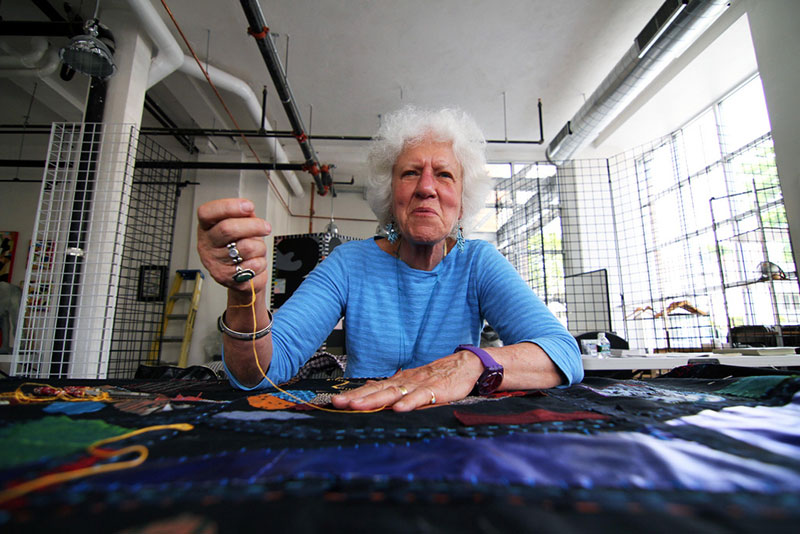
Clara Wainwright works on the Mending Boston Collage Quilt, 2013. Photo: PD Rosso. Courtesy the artist.
Clara Wainwright is a living legend, the one-woman powerhouse behind some of Boston’s most ambitious arts initiatives of the past four decades. Many of her pie in the sky ideas were concocted at her kitchen table among friends. Most notably, First Night, Boston’s arts centric New Year’s Eve celebration, which she founded in 1975. It has since been replicated in over 200 cities around the globe. However, it is her community quilting projects around Boston that have lifted spirits and touched the lives of many over the years.
Clara Wainwright. Small Gift, 2013. Fabric and thread; 29 x 30.5 inches. Photo: Richard Howard. Courtesy the artist.
Wainwright grew up in a Massachusetts private school system where art education was an afterthought, and she considered her own drawing abilities “silly.”1 Still, she wanted a career in the arts but wasn’t exactly waiting around for opportunities. It wasn’t until her son, Dedalus, was born that she discovered her calling. Upon his birth, Dedalus was given an extraordinary patchwork blanket of countless shapes and colors—lovingly deemed the “crazy quilt.” Astounded by the craftsmanship and enamored with the composition, Wainwright was inspired to study the craft herself.
After weeks of practicing on pillows and, later, recreating the works of old masters (Picasso, Klee, Modigliani), she had discovered a medium that forgave her lack of precision. She was free to realize ideas that had been swimming around in her head for years. “Once I finally discovered fabric, it opened up this huge river of creativity, which I hadn’t experienced before. It was as if I had magic hands and I was able to create new worlds.”
Clara Wainwright works on the Mending Boston Collage Quilt, 2013. Photo: PD Rosso. Courtesy the artist.
Described as a “curator of people” by her friends, Wainwright decided to apply her newfound artistic abilities to collaborative projects aimed at helping people affected by tragedies such as September 11 and the Boston Marathon bombing.
Following the 2003 invasion of Iraq, the “shock and awe” moment as Clara remembers, she brought members of the community together for the Mending Baghdad Project. The initiative resulted in a large-scale quilt that depicted Baghdad during the first nights of the Iraq war.
Clara Wainwright and team. Mending Baghdad, 2003. Fabric and thread; 54 x 78 inches. Courtesy the artist.
Wainwright found the quilt’s source image on the front cover of a newspaper, and within a few days had started her own rendition in fabric. However, instead of sewing the pieces of the composition together (as quilters might do in the final stage of the process), Wainwright chose to glue the individual components to the surface and leave the sewing to a group. “I deliberately left it unfinished. The idea was that it wouldn’t hold together unless people mended it.”
Wainwright enlisted the help of her community, holding workshops around Greater Boston where she brought individuals together to complete the quilt, laugh, gossip, and cry. Some conversations between participants happened with the artist acting as a silent observer. At other times they looked to her directly as an outlet. Either way, it was a chance for people to start to heal, piece by piece.
Participants work on the Mending Boston Quilt Project at the Boston Asian Youth Essential Service in Chinatown, 2013. Photo: Aram Boghosian for The Boston Globe.
These days people don’t do much mending, they just throw things away and buy a new one. There is a sense of disposability nowadays. But mending is terribly important, a quiet kind of act. It’s a way of getting people to sit down and work on something and gives them a chance to talk and express how they’re feeling.
Wainwright has gone on to create over sixty community quilts, bringing her projects to people who, like herself, may not have had the good fortune of growing up with art in their lives. Wainwright has spent much of her career using her fabric-based art to tell stories within diverse communities—stories that are seldom sought out but begging to be heard.
Wainwright has a magic about her, an innate ability to bring together people that have vastly different backgrounds and experiences, people who might not otherwise meet. She equips them with the tools they need to get started and then sits back to watch an invisible thread bind everyone together. With a head full of ideas and a heart full of openness, Wainwright continues to play a pivotal role in shaping the Boston we know and love today.
1. This and all subsequent quotes are from the author’s phone conversation with the artist on May 23, 2014.